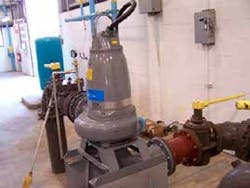Flygt N-Pump in Auburn, IN
A city of 13,000, Auburn, Indiana operates an activated sludge secondary WWTP facility. Located within commuting distance north of Fort Wayne, the municipal utility’s six-square-mile service area has historically experienced pronounced peak flows caused by nearly one-fourth of its collection system consisting of combined storm water and sanitary sewer lines. Complicating matters, the system’s jet mixing pumps repeatedly clogged, resulting in costly maintenance and aggravated plant employees.
Scope
To deal with the situation, the city of Auburn embarked on a new plant design project that would also utilize a legacy plant to manage peak flows and boost overall peak system capacity. For the project to succeed, the city had to improve the sludge handling process at the existing plant—a weak link at the end of its six-stage process chain.
“Normally, the original pump would operate for only a week or less before clogging with debris, fibrous material or other solids,” recalls Dave Capp, with the municipal utility.
The jet mixing pump that mixed the sludge in the 186,500-gallon holding tank just ahead of the dewatering press repeatedly clogged. Without agitation, solids and debris settled to the bottom of the tank making it harder to run through the belt press and compromised pumping efficiency. As a result, inconsistently mixed sludge reached the injection port causing clogs and the pumps had to be pulled out of service for repair at a costly $500 in man-hours per incident.
Solution
The typical response to persistent clogs would have been a chopper, screw or other “clog resistant” pump. However, given the 1.0 – 4.5 percent solids in the raw sludge holding tank, a more robust solution was required.
Auburn selected the award-winning Xylem Flygt N-Pump, designed to handle concentrated solids in difficult applications. The secret to clog-resistant N-type pump’s performance resides in its geometrically advanced impeller and wear ring design that prevents rags, fibrous or other material from accumulating on the impeller’s leading edges. The innovative impeller is a geometric improvement over the axial leading edge of most impellers.
When configured for jet mixing, as applied to the Auburn plant, the swept-back leading edge of the impeller and a relief groove in the volute of the N-type units inherently resist clogs by easing the passage of any stubborn material that reaches the raw sludge holding tank. As the impeller turns, suspended fibrous material and any solids drawn into the pump suction are spun outward to the discharge where it is then flushed away.
The secret to clog-resistant N-type pump’s performance resides in its geometrically advanced impeller and wear ring design.
Result
The innovative Flygt N-pumps have operated reliably without the frequent clogs that previously imposed downtime – eliminating nearly $25,000 in maintenance costs per year.
In addition, the city of Auburn realized significant energy savings as a result of the pump’s operating efficiency. According to Xylem research, 70 percent efficiency is the highest rating for a typical single-vane pump in a best-specific speed range. The Flygt N-Pump delivers 80 percent or higher efficiency, which equates to 15 percent less power consumption and significant energy savings each year.
The frequent clogging experienced with the former pumps is now just a distant, unpleasant memory.
Editor's Note: Scranton Gillette Communications and the SGC Water Group are not liable for the accuracy, efficacy and validity of the claims made in this piece. The views expressed in this content do not reflect the position of the editorial teams of Water & Wastes Digest, Water Quality Products and Storm Water Solutions.

